Aerobiological Pollen Deposition and Transport of Fraxinus excelsior L. at a Small Spatial Scale
Abstract
:1. Introduction
1.1. Ash Dieback—Background
1.2. Consequences of the Ash Population Decline
1.3. Seed Plantations
1.4. Previous Studies on Pollen Transport
1.5. Aim of the Study
2. Materials and Methods
2.1. Study Area
2.2. Aerobiological Pollen Measurements
2.3. Phenological Observations
2.4. Meteorological Parameters
2.5. Statistical Analyses
3. Results
3.1. Plantation Schorndorf
3.1.1. Total Pollen Catch in Relation to Phenology, Temperature and Precipitation
3.1.2. Pollen Catch at the Four Traps
3.1.3. KLAM_21
3.2. Plantation Emmendingen
3.2.1. Total Pollen Catch in Relation to Phenology, Temperature and Precipitation
3.2.2. Pollen Catch at the Four Traps
4. Discussion
4.1. Relationships between Pollen Catch, Phenology, Temperature, and Precipitation
4.2. Estimation of Pollen Transport Distances
5. Conclusions
Author Contributions
Funding
Institutional Review Board Statement
Informed Consent Statement
Data Availability Statement
Acknowledgments
Conflicts of Interest
Appendix A
| 1992/1995 | 2019 | 2020 | ||
|---|---|---|---|---|
| Schorndorf | Number of clones | 68 | 36 | 36 |
| Number of ash trees | 416 | 120 | 120 | |
| Thereof female | 288 | 51 | 51 | |
| Thereof male | 128 | 54 | 54 | |
| Thereof hermaphrodite | included in the category “female” | 15 | 15 | |
| Thereof healthy ash trees | 33% | 27% | ||
| Thereof damaged ash trees | 67% | 73% | ||
| Emmendingen | Number of clones | 49 | 32 | 32 |
| Number of ash trees | 228 | 86 | 86 | |
| Thereof female | NA | 17 | 17 | |
| Thereof male | NA | 49 | 49 | |
| Thereof hermaphrodite | NA | 20 | 20 | |
| Thereof healthy ash trees | 52% | 38% | ||
| Thereof damaged ash trees | 58% | 62% |



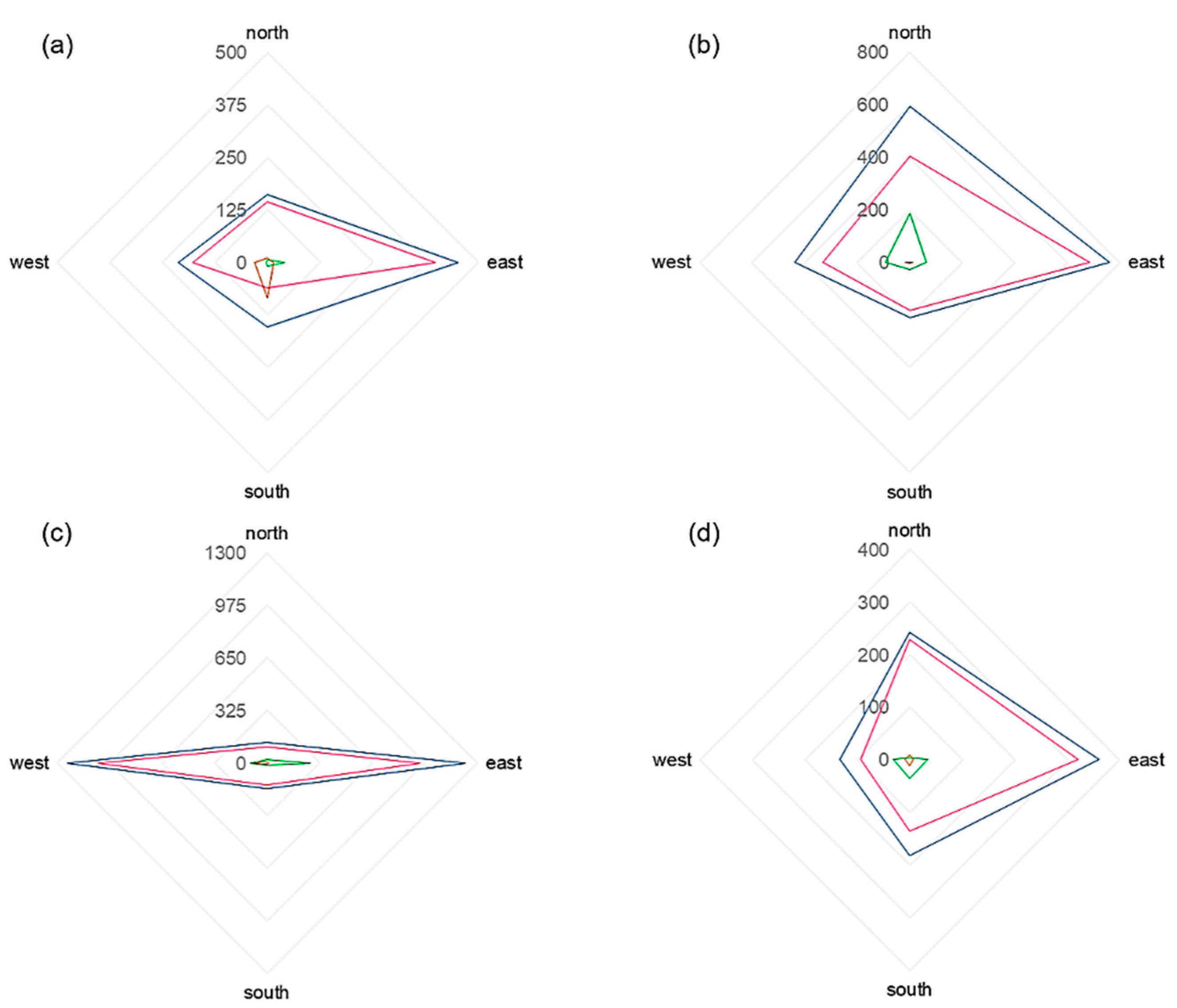

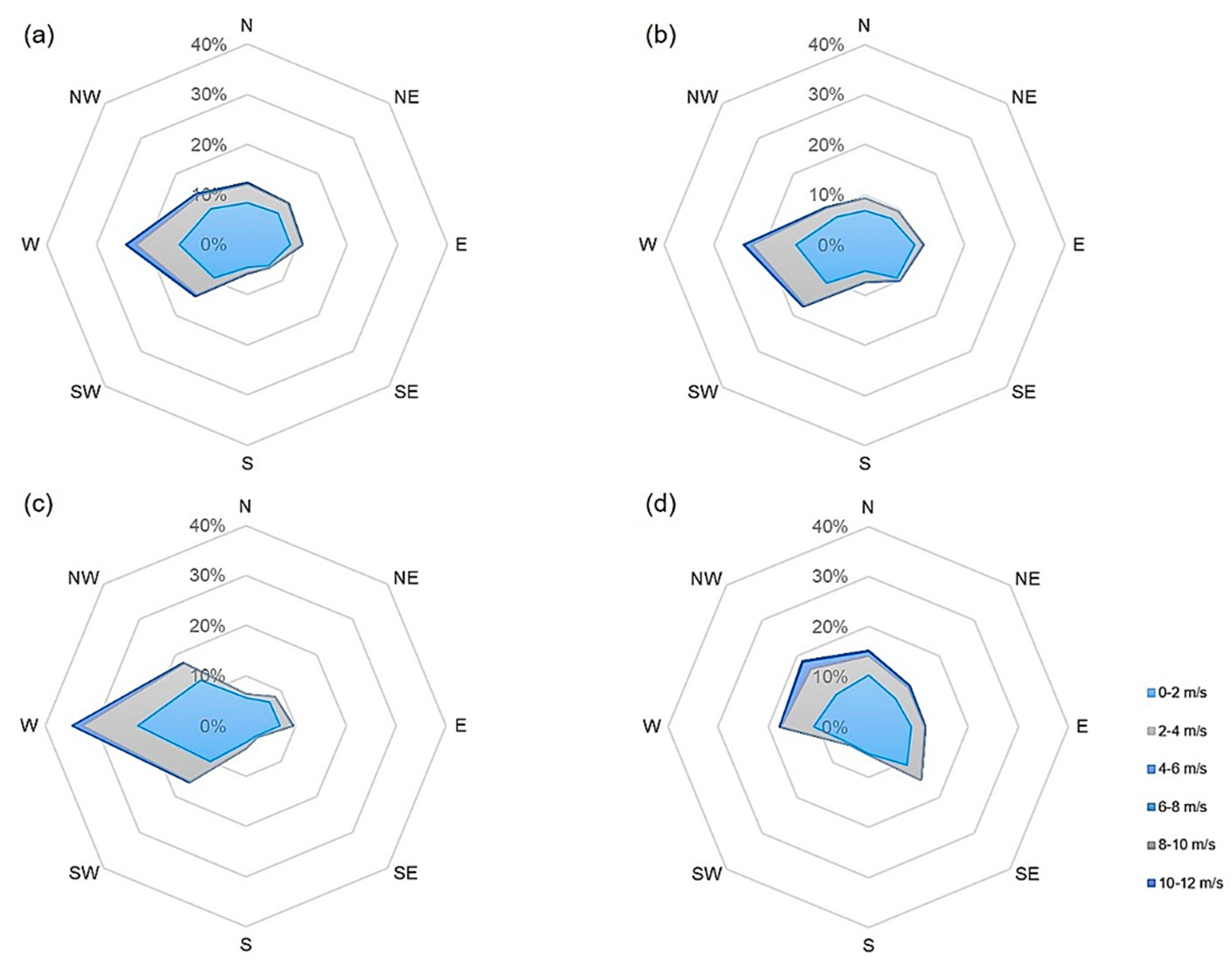





References
- Heuertz, M.; Fineschi, S.; Anzidei, M.; Pastorelli, R.; Salvini, D.; Paule, L.; Frascaria-Lacoste, N.; Hardy, O.J.; Vekemans, X.; Vendramin, G.G. Chloroplast DNA variation and postglacial recolonization of common ash (Fraxinus excelsior L.) in Europe. Mol. Ecol. 2004, 13, 3437–3452. [Google Scholar] [CrossRef] [PubMed]
- Gassner, M.; Schmid-Grendelmeier, P.; Clot, B. Ash pollen allergy and aerobiology. Allergo. J. Int. 2019, 28, 289–298. [Google Scholar] [CrossRef] [Green Version]
- Enderle, R.; Fussi, B.; Lenz, H.D.; Langer, G.; Nagel, R.; Metzler, B. Ash Dieback in Germany: Research on Disease Development, Resistance and Management Options. In Dieback of European Ash (Fraxinus spp.): Consequences and Guidelines for Sustainable Management; Vasaitis, R., Enderle, R., Eds.; European Cooperation in Science & Technology (COST): Uppsala, Sweden, 2017; pp. 89–105. ISBN 978-91-576-8696-1. [Google Scholar]
- Hultberg, T.; Sandström, J.; Felton, A.; Öhman, K.; Rönnberg, J.; Witzell, J.; Cleary, M. Ash dieback risks an extinction cascade. Biol. Conserv. 2020, 244, 108516. [Google Scholar] [CrossRef]
- Jochner-Oette, S.; Rohrer, T.; Eisen, A.-K.; Tönnes, S.; Stammel, B. Influence of Forest Stand Structure and Competing Understory Vegetation on Ash Regeneration—Potential Effects of Ash Dieback. Forests 2021, 12, 128. [Google Scholar] [CrossRef]
- Metzler, B.; Enderle, R.; Karopka, M.; Töpfner, K.; Aldinger, E. Development of Ash dieback in a provenance trial on different sites in southern Germany. Allg. Forst-Und Jagdztg. 2012, 183, 168–180. [Google Scholar]
- McKinney, L.V.; Nielsen, L.R.; Collinge, D.B.; Thomsen, I.M.; Hansen, J.K.; Kjaer, E.D. The ash dieback crisis: Genetic variation in resistance can prove a long-term solution. Plant Pathol. 2014, 63, 485–499. [Google Scholar] [CrossRef]
- Enderle, R. An overview of ash (Fraxinus spp.) and the ash dieback disease in Europe. CAB Rev. 2019, 14, 1–12. [Google Scholar] [CrossRef] [Green Version]
- Kowalski, T.; Holdenrieder, O. Pathogenicity of Chalara fraxinea. For. Pathol. 2009, 39, 1–7. [Google Scholar] [CrossRef]
- Timmermann, V.; Børja, I.; Hietala, A.M.; Kirisits, T.; Solheim, H. Ash dieback: Pathogen spread and diurnal patterns of ascospore dispersal, with special emphasis on Norway. EPPO Bull. 2011, 41, 14–20. [Google Scholar] [CrossRef]
- Pautasso, M.; Aas, G.; Queloz, V.; Holdenrieder, O. European ash (Fraxinus excelsior) dieback—A conservation biology challenge. Biol. Conserv. 2013, 158, 37–49. [Google Scholar] [CrossRef]
- Rigling, D.; Hilfiker, S.; Schöbel, C.; Meier, F.; Engesser, R.; Scheidegger, C.; Stofer, S.; Senn-Irlet, B.; Queloz, V. Das Eschentriebsterben. Biologie, Krankheitssymptome und Handlungsempfehlungen. Merkbl. Für Die Prax. 2016, 57, 1–8. [Google Scholar]
- Gross, A.; Holdenrieder, O.; Pautasso, M.; Queloz, V.; Sieber, T.N. Hymenoscyphus pseudoalbidus, the causal agent of European ash dieback. Mol. Plant Pathol. 2014, 15, 5–21. [Google Scholar] [CrossRef] [PubMed]
- Pliūra, A.; Bakys, R.; Suchockas, V.; Marčiulynienė, D.; Gustienė, A.; Verbyla, V.; Lygis, V. Ash dieback in Lithuania: Disease history, research on impact and genetic Ash dieback in Lithuania: Disease history, research on impact and genetic variation in disease resistance, tree breeding and options for forest management. In Dieback of European Ash (Fraxinus spp.):, Consequences and Guidelines for Sustainable Management; Vasaitis, R., Enderle, R., Eds.; European Cooperation in Science & Technology (COST): Uppsala, Sewden, 2017; pp. 150–165. ISBN 978-91-576-8696-1. [Google Scholar]
- ForstBW. Herausforderung Eschentriebsterben: Waldbauliche Behandlung Geschädigter Eschenbestände, Stuttgart. 2018. Available online: https://www.forstbw.de/fileadmin/forstbw_infothek/forstbw_praxis/ForstBW_Praxis_Eschentriebsterben_20180327.pdf (accessed on 29 November 2021).
- Lygis, V.; Bakys, R.; Gustiene, A.; Burokiene, D.; Matelis, A.; Vasaitis, R. Forest self-regeneration following clear-felling of dieback-affected Fraxinus excelsior: Focus on ash. Eur. J. For. Res. 2014, 133, 501–510. [Google Scholar] [CrossRef]
- Heinze, B.; Tiefenbacher, H.; Litschauer, R.; Kirisits, T. Ash dieback in Austria—history, current situation and outlook. In Dieback of European Ash (Fraxinus spp.): Consequences and Guidelines for Sustainable Management; Vasaitis, R., Enderle, R., Eds.; European Cooperation in Science & Technology (COST): Uppsala, Sweden, 2017; pp. 33–52. ISBN 978-91-576-8696-1. [Google Scholar]
- Coker, T.L.R.; Rozsypálek, J.; Edwards, A.; Harwood, T.P.; Butfoy, L.; Buggs, R.J.A. Estimating mortality rates of European ash (Fraxinus excelsior) under the ash dieback (Hymenoscyphus fraxineus) epidemic. Plants People Planet 2019, 1, 48–58. [Google Scholar] [CrossRef] [Green Version]
- Fussi, B.; Konnert, M.; Cremer, E. Genfluss in Waldbeständen. LWF Wissen 2014, 74, 22–26. [Google Scholar]
- Semizer-Cuming, D.; Chybicki, I.J.; Finkeldey, R.; Kjær, E.D. Gene flow and reproductive success in ash (Fraxinus excelsior L.) in the face of ash dieback: Restoration and conservation. Ann. For. Sci. 2021, 78, 14. [Google Scholar] [CrossRef]
- Fussi, B.; Enderle, R.; Karopka, M.; Zollner, A.; Baier, R.; Konnert, M. Ansätze zur Resistenzzüchtung gegenüber Eschentriebsterben. AFZ-Der Wald 2016, 71, 18–21. [Google Scholar]
- Bochenek, G.M.; Eriksen, B. First Come, First Served: Delayed Fertilization Does Not Enhance Pollen Competition in a Wind-Pollinated Tree, Fraxinus excelsior L. (Oleaceae). Int. J. Plant Sci. 2011, 172, 60–69. [Google Scholar] [CrossRef] [Green Version]
- Chybicki, I.J.; Burczyk, J. Seeing the forest through the trees: Comprehensive inference on individual mating patterns in a mixed stand of Quercus robur and Q. petraea. Ann. Bot. 2013, 112, 561–574. [Google Scholar] [CrossRef] [Green Version]
- Gleiser, G.; Chybicki, I.J.; González-Martínez, S.C.; Aizen, M.A. Phenological match drives pollen-mediated gene flow in a temporally dimorphic tree. Plant Biol. 2018, 20, 93–100. [Google Scholar] [CrossRef]
- German Forest Reproduction Act, FoVG (2002) In: BGBl. I p.1658. Available online: https://www.gesetze-im-internet.de/fovg/BJNR165800002.html (accessed on 7 February 2022).
- Heuertz, M.; Vekemans, X.; Hausman, J.-F.; Palada, M.; Hardy, O.J. Estimating seed vs. pollen dispersal from spatial genetic structure in the common ash. Mol. Ecol. 2003, 12, 2483–2495. [Google Scholar] [CrossRef] [PubMed]
- Bacles, C.F.E.; Ennos, R.A. Paternity analysis of pollen-mediated gene flow for Fraxinus excelsior L. in a chronically fragmented landscape. Hered. (Edinb) 2008, 101, 368–380. [Google Scholar] [CrossRef] [PubMed] [Green Version]
- Thomasset, M.; Hodkinson, T.R.; Restoux, G.; Frascaria-Lacoste, N.; Douglas, G.C.; Fernández-Manjarrés, J.F. Thank you for not flowering: Conservation genetics and gene flow analysis of native and non-native populations of Fraxinus (Oleaceae) in Ireland. Heredity 2014, 112, 596–606. [Google Scholar] [CrossRef] [PubMed] [Green Version]
- Scheifinger, H.; Belmonte, J.; Buters, J.; Celenk, S.; Damialis, A.; Dechamp, C.; García-Mozo, H.; Gehrig, R.; Grewling, L.; Halley, J.M.; et al. Monitoring, Modelling and Forecasting of the Pollen Season. In Allergenic Pollen: A Review of the Production, Release, Distribution and Health Impacts; Sofiev, M., Bergmann, K.-C., Eds.; Springer: Dordrecht, The Netherlands, 2013; pp. 71–126. ISBN 978-94-007-4880-4. [Google Scholar]
- Adams-Groom, B.; Skjøth, C.A.; Baker, M.; Welch, T.E. Modelled and observed surface soil pollen deposition distance curves for isolated trees of Carpinus betulus, Cedrus atlantica, Juglans nigra and Platanus acerifolia. Aerobiologia 2017, 33, 407–416. [Google Scholar] [CrossRef]
- Šikoparija, B.; Marko, O.; Panić, M.; Jakovetić, D.; Radišić, P. How to prepare a pollen calendar for forecasting daily pollen concentrations of Ambrosia, Betula and Poaceae? Aerobiologia 2018, 34, 203–217. [Google Scholar] [CrossRef]
- Anderson, R.S. Modern pollen rain within and adjacent to two giant sequoia (Sequoiadendrongiganteum ) groves, Yosemite and Sequoia national parks, California. Can. J. For. Res. 1990, 20, 1289–1305. [Google Scholar] [CrossRef]
- Bricchi, E.; Frenguelli, G.; Mincigrucci, G. Experimental results about Platanus pollen deposition. Aerobiologia 2000, 16, 347–352. [Google Scholar] [CrossRef]
- DWD. Deutscher Wetterdienst/German Meteorological Service. Available online: https://www.dwd.de/DE/Home/home_node.html (accessed on 16 December 2021).
- LGRB. LGRB-Kartenviewer:—Layer Bodenkunde: Reliefparameter. Available online: https://maps.lgrb-bw.de/ (accessed on 16 December 2021).
- Lenz, H.; Straßner, L.; Baumann, M.; Baier, U. Boniturschlüssel zur Einstufung der Vitalität von Alteschen. AFZ-Der Wald. 2012, 3, 18–129. [Google Scholar]
- Durham, O.C. The volumetric incidence of atmospheric allergens. J. Allergy 1946, 17, 79–86. [Google Scholar] [CrossRef]
- Jetschni, J.; Jochner-Oette, S. Spatial and Temporal Variations of Airborne Poaceae Pollen along an Urbanization Gradient Assessed by Different Types of Pollen Traps. Atmosphere 2021, 12, 974. [Google Scholar] [CrossRef]
- Meier, U. Entwicklungsstadien Mono-und Dikotyler Pflanzen. BBCH-Monographie, 2nd ed.; Blackwell Wissenschaftsverlag: Berlin, Germany, 2001. [Google Scholar]
- Stakeman, E.C.; Harrar, J.G. Principles of Plant Pathology; Ronald Press: New York, NY, USA, 1957. [Google Scholar]
- Sievers, U. Das Kaltluftabflussmodell KLAM_21: Theoretische Grundlagen, Anwendung und Handhabung des PC-Modells; Selbstverl. des Deutschen Wetterdienstes: Offenbach am Main, Germany, 2005; ISBN 3881484078. [Google Scholar]
- Kossmann, M.; Sievers, U. Klam_21 Drainage Wind Modelling of Wintertime Air Pollution Events in Christchurch, New Zealand. In Proceedings of the 29th International Conference on Alpine Meteorology, Chambéry, France, 4–8 June 2007; Volume 1, pp. 29–32. [Google Scholar]
- Estrella, N.; Menzel, A.; Krämer, U.; Behrendt, H. Integration of flowering dates in phenology and pollen counts in aerobiology: Analysis of their spatial and temporal coherence in Germany (1992–1999). Int. J. Biometeorol. 2006, 51, 49–59. [Google Scholar] [CrossRef] [PubMed]
- Jochner, S.; Ziello, C.; Böck, A.; Estrella, N.; Buters, J.; Weichenmeier, I.; Behrendt, H.; Menzel, A. Spatio-temporal investigation of flowering dates and pollen counts in the topographically complex Zugspitze area on the German–Austrian border. Aerobiologia 2012, 28, 541–556. [Google Scholar] [CrossRef]
- Menzel, A.; Fabian, P. Growing season extended in Europe. Nature 1999, 397, 659. [Google Scholar] [CrossRef]
- Badeck, F.-W.; Bondeau, A.; Böttcher, K.; Doktor, D.; Lucht, W.; Schaber, J.; Sitch, S. Responses of spring phenology to climate change. New Phytol. 2004, 162, 295–309. [Google Scholar] [CrossRef]
- Laaidi, M. Forecasting the start of the pollen season of Poaceae: Evaluation of some methods based on meteorological factors. Int. J. Biometeorol. 2001, 45, 1–7. [Google Scholar] [CrossRef]
- Jochner, S.; Heckmann, T.; Becht, M.; Menzel, A. The integration of plant phenology and land use data to create a GIS-assisted bioclimatic characterisation of Bavaria, Germany. Plant Ecol. Divers. 2011, 4, 91–101. [Google Scholar] [CrossRef]
- Šikoparija, B.; Mimić, G.; Panić, M.; Marko, O.; Radišić, P.; Pejak-Šikoparija, T.; Pauling, A. High temporal resolution of airborne Ambrosia pollen measurements above the source reveals emission characteristics. Atmos. Environ. 2018, 192, 13–23. [Google Scholar] [CrossRef]
- Fægri, K. Textbook of Pollen Analysis, 4th ed.; Knut, F., Peter, E.K., Knut, K., Eds.; Blackburn Press: Caldwell, NJ, USA, 2000; ISBN 1-930665-01-6. [Google Scholar]
- Skjøth, C.A.; Ørby, P.V.; Becker, T.; Geels, C.; Schlünssen, V.; Sigsgaard, T.; Bønløkke, J.H.; Sommer, J.; Søgaard, P.; Hertel, O. Identifying urban sources as cause of elevated grass pollen concentrations using GIS and remote sensing. Biogeosciences 2013, 10, 541–554. [Google Scholar] [CrossRef] [Green Version]

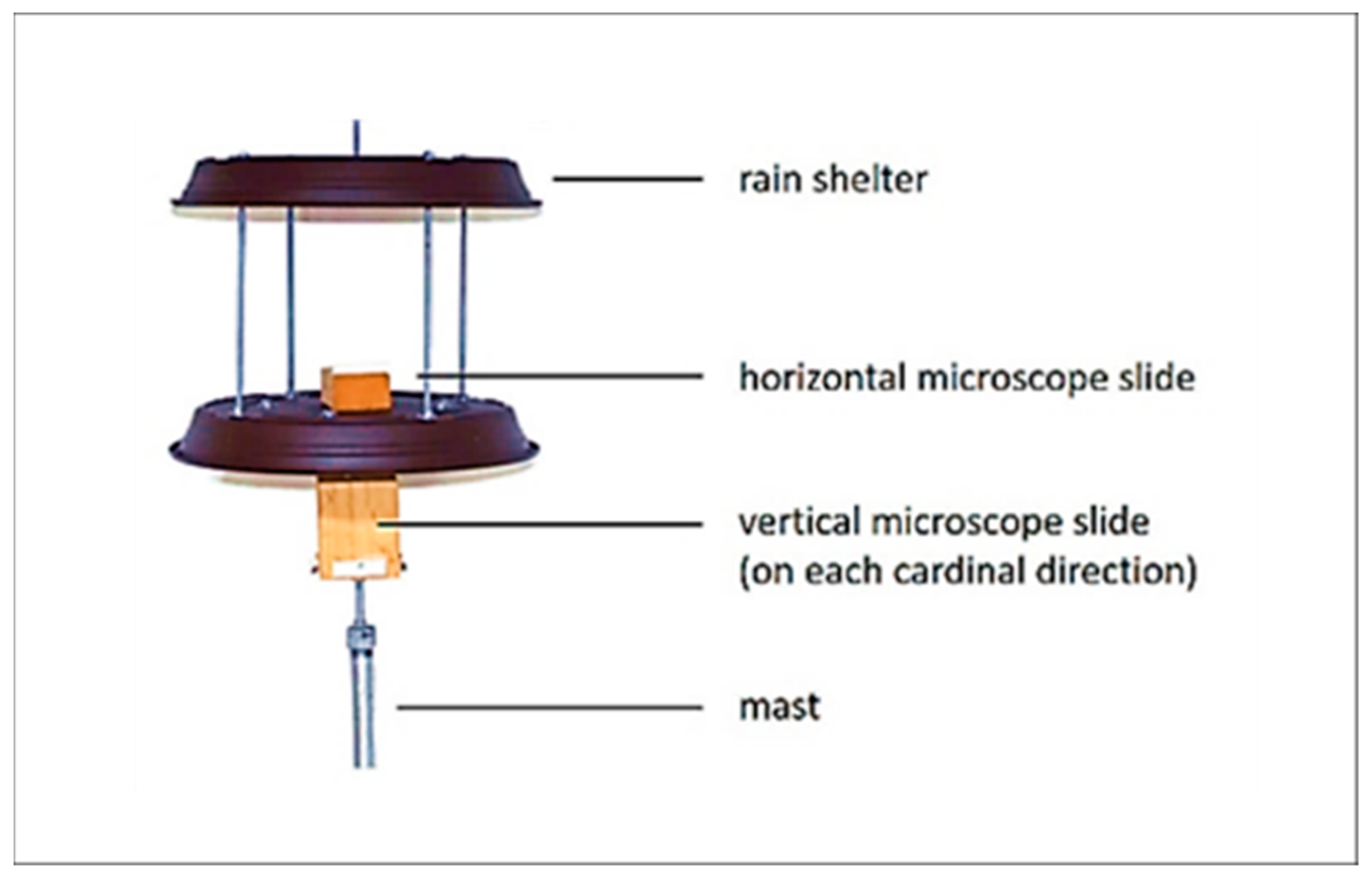



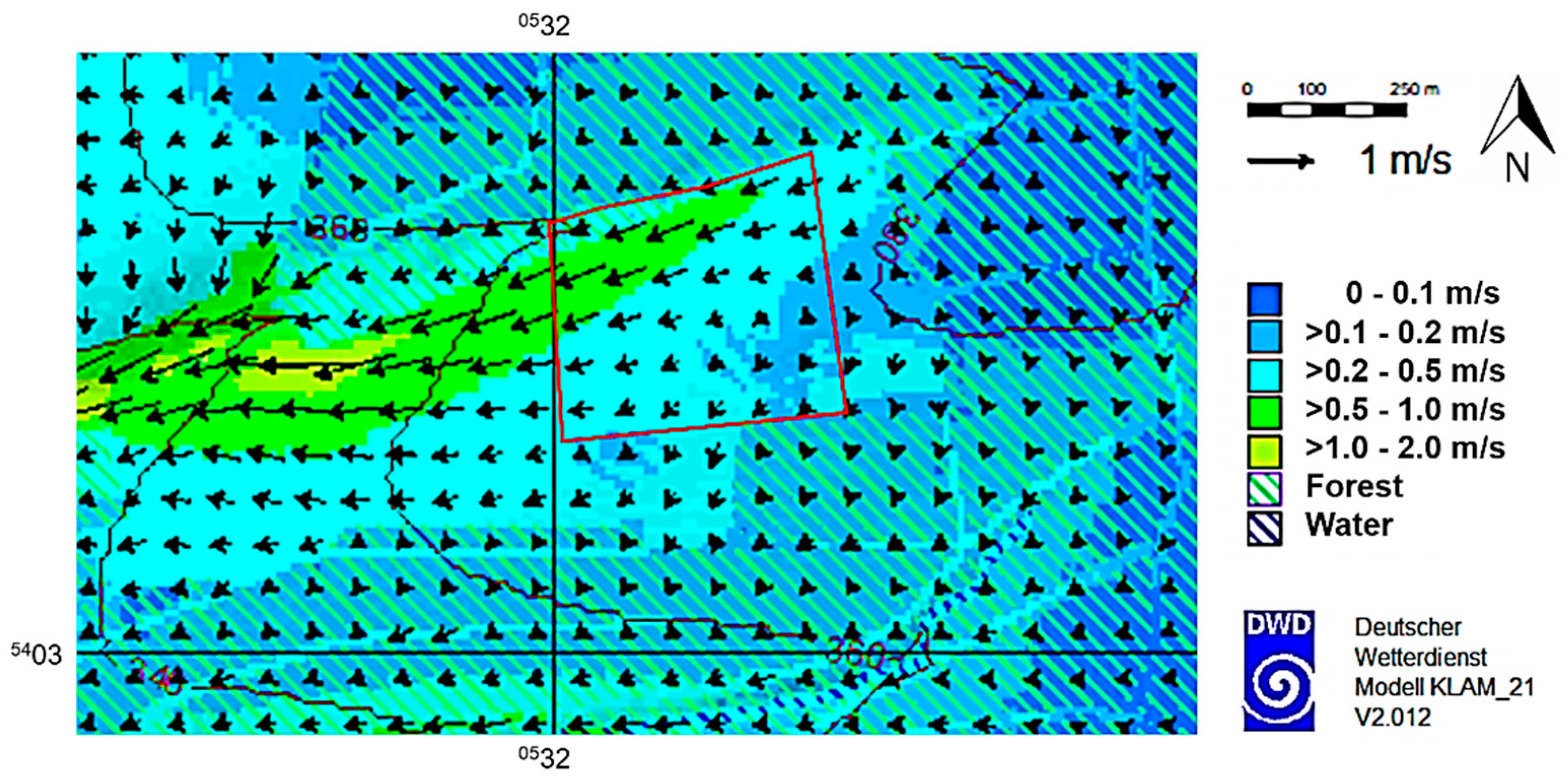
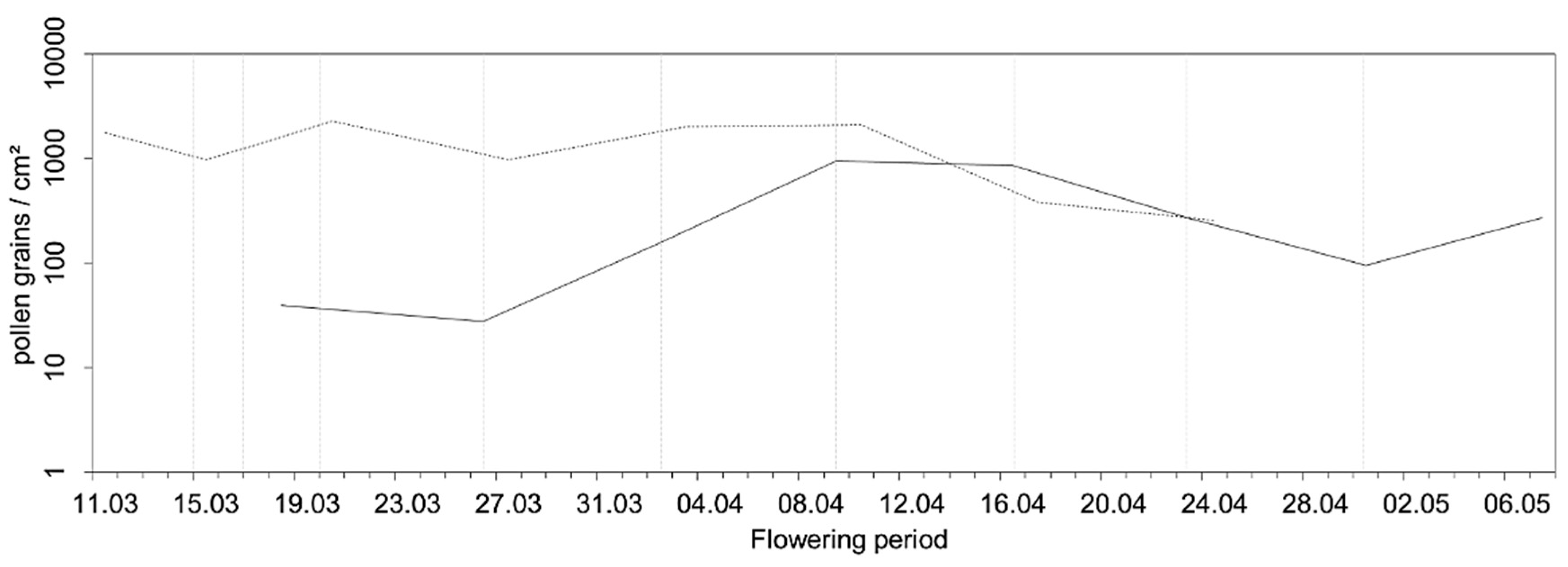

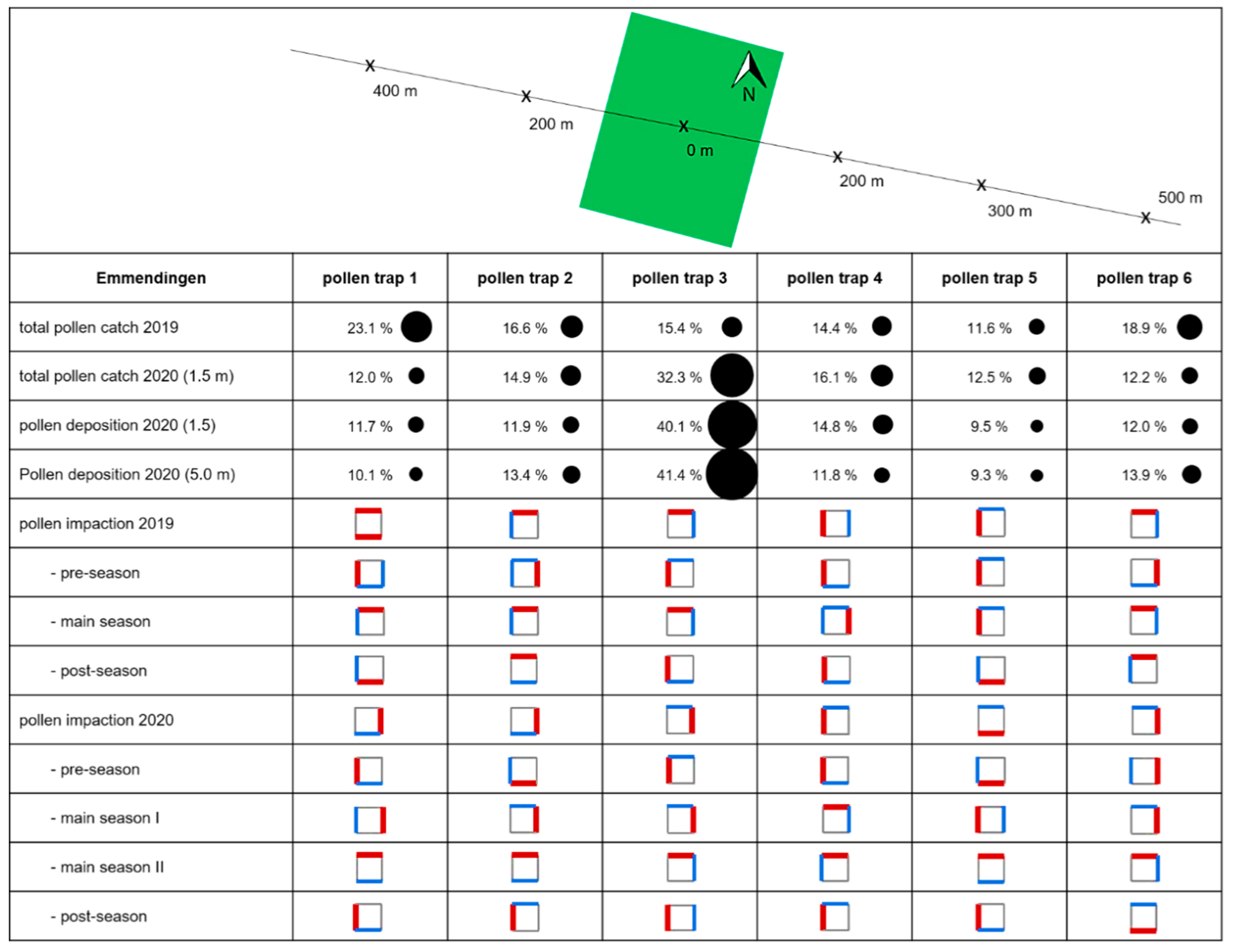
| Pollen Season | 2019 | 2020 |
|---|---|---|
| Pre-season | 18 March–2 April | 18 March–25 March |
| Main season | 2 April–23 April | 25 March–22 April |
| Post-season | 23 April–14 May | 22 April–13 May |
| Pollen Season | 2019 | 2020 |
|---|---|---|
| Pre-season | 18 March–9 April | 11 March–17 March |
| Main season | 9 April–23 April | 17 March–17 April |
| Post-season | 23 April–14 May | 17 April–1 May |
| Trap 1 | Trap 2 | Trap 3 | Trap 4 | Trap 5 | Trap 6 | |
|---|---|---|---|---|---|---|
| peak dates 1.5 m | 20.03–27.03 | 11.03–15.03, 10.04–17.04 | 03.04–10.04 | 03.04–10.04 | 10.04–17.04 | 03.04–10.04 |
| Max. pollen 1.5 m [pollen grains/cm2] | 107 | 104 | 424 | 139 | 106 | 139 |
| peak dates 5.0 m | 10.04–17.04 | 03.04–10.04 | 17.03–20.03 | 10.04–17.04 | 10.04–17.04 | 03.04–10.04 |
| Max. pollen 5.0 m [pollen grains/cm2] | 102 | 120 | 681 | 151 | 105 | 149 |
Publisher’s Note: MDPI stays neutral with regard to jurisdictional claims in published maps and institutional affiliations. |
© 2022 by the authors. Licensee MDPI, Basel, Switzerland. This article is an open access article distributed under the terms and conditions of the Creative Commons Attribution (CC BY) license (https://creativecommons.org/licenses/by/4.0/).
Share and Cite
Eisen, A.-K.; Fussi, B.; Šikoparija, B.; Jochner-Oette, S. Aerobiological Pollen Deposition and Transport of Fraxinus excelsior L. at a Small Spatial Scale. Forests 2022, 13, 424. https://doi.org/10.3390/f13030424
Eisen A-K, Fussi B, Šikoparija B, Jochner-Oette S. Aerobiological Pollen Deposition and Transport of Fraxinus excelsior L. at a Small Spatial Scale. Forests. 2022; 13(3):424. https://doi.org/10.3390/f13030424
Chicago/Turabian StyleEisen, Anna-Katharina, Barbara Fussi, Branko Šikoparija, and Susanne Jochner-Oette. 2022. "Aerobiological Pollen Deposition and Transport of Fraxinus excelsior L. at a Small Spatial Scale" Forests 13, no. 3: 424. https://doi.org/10.3390/f13030424






